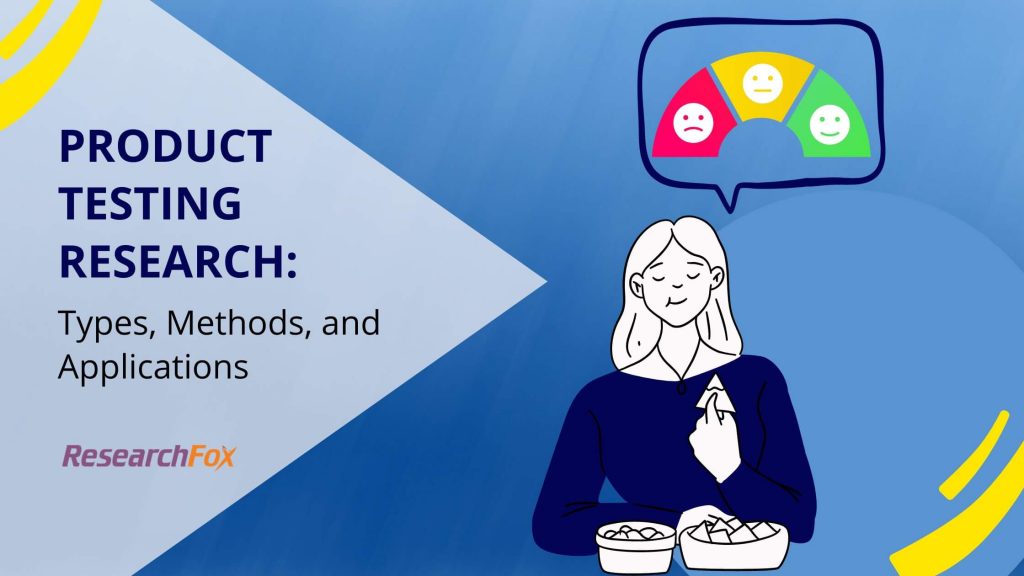To every marketing and product development executive, the value of product testing research is often one of the most complicated issues of all time. This difficulty multiplies when the goals of product testing research are sometimes unclear and that the information, once gathered, is often not utilized at its best.
Beginning with the importance of product testing research across different categories, the article clears why brands need product testing research, what should it aim at, its different types, and methods, and How do we conduct an end-to-end product Testing Research
Why do brands need product testing research?
However, sooner or later, brands need to validate some of the new product ideas on their audience and build a product prototype according to consumer feedback. Now, the next step is to launch the product or start mass production but before proceeding to that, just like every other feedback loop, product and marketing executives need to make their audience consume/use the prototype, collect feedback from them, and iterate their prototype or MVPs (Minimal Viable Products) to find out mistakes that have been made before those mistakes grow exponentially.
Product testing research enables brands to gauge consumer interest and receive feedback on areas that need improvement by testing the products with real audiences. It enables the understanding of consumer preferences, choices, and drivers that will determine if the product will succeed or fail in a particular market.
Test marketing the product with the target audience in specific scenarios where the audience consumes the product and records their feedback allows for the collection of data that will enable the product to be improved, maintained, and expand its market share against existing competitor products.
Here are some of the key applications of product testing research:
- Create a better product and experience than competitive products.
- Analyze the performance of competitive products and mitigate potential risks
- Optimize manufacturing and production cost
- Measure the effects of external factors and analyze shelf-life
- Quality testing of products from different factories.
- Acceptance of new products by the target consumers
- Finding the optimal set of ingredients or features at a given price point or profit goal
What should a product test research aim?
The goal of product testing should be set after a profound understanding of what you want to know about your product. The below pointers can help in setting just the right goal for your product testing research:
- The aspects of a product or service that generate the most favorable or unfavorable attention
- The features and benefits of the product that make the product easier or harder to use
- The resulting consumer sentiment that will be surrounding the product post usage
Conducting test marketing in new product development ensures that you build a better customer experience around the product. This type of research is vital to product innovation and development as it minimizes the risk of wasting valuable time and marketing budget by focusing efforts and resources in the right direction, increasing the chances for success.
Types of Product Testing Research:
1. New product development Research:
This type of research unveils the perception of the customers about the particular category of products to find existing needs, their likes and dislikes, factors driving their purchase decisions, the effectiveness of product features and benefits, ability to meet the needs of the category in the market.
2. Value Engineering Research:
It enables the business to meet cost and pricing optimization goals by competitive analysis of the reengineered product with other versions. The products are tested with target users to check their liking, perceived differences in value, thoughts, and feelings about the differences, and the impact that the new value will have on their purchase volume and decisions.
3. Competitive Benchmarking Research:
This research conducts comparative research of the product against the existing competitor products. The audience uses, consumes, or experiences the product along with competitor products as a point of comparison. The feedback and responses of the audience are then used to analyze and predict the performance of the product in the market against existing players.
Product testing research methods:
1. Monadic Testing:
In this method, the respondent is given an individual product or concept for test consumption. The product is tested alone separate from any other concepts. Testing a single concept at a time ensures that the feedback is free of any biases from other concepts and also stimulates a real-life scenario where we interact with one concept at a time. Testing one concept at a time with a real audience ensures more accurate, actionable, and detailed insights about the product.
2. Sequential Monadic Testing:
In this setting, the respondent uses one product and evaluates it and then uses the second product and evaluates it, and so on. This is best suited for understanding small details and differences between two or more products.
The sequential monadic test also involves the “suppression effect” whereby all the scores are lower compared to the monadic test and the “interaction effect” whereby the exceptionally good products report much higher scores as compared to the other products in the sequence.
3. Paired comparison testing:
In this design, the respondents are shown two products and asked to choose one as per their preferences. The test measures minute differences between products and concepts but fails to analyze if both products are good or bad in the category.
4. Protomonadic testing:
This method is designed as a combination of monadic testing followed by paired comparison testing. It reveals detailed and comprehensive data and the paired comparison in the later part validated the results for accuracy.
How do we conduct an end-to-end product Testing Research
At ResearchFox, we do powerful product testing research projects which help brands unlock tremendous insights about their products and their potential consumers. Our dedicated team of research professionals has been working with global brands to test their products with real audiences, making product testing research one of our core competencies.
Our team of research professionals specializes in leading product testing research studies across many product categories such as-
- Mobile Apps
- Software and Websites
- Packaged Food and Beverages
- Health and Beauty
- Apparel
- Home Care Products
- Pet Care Products
- Quick Service Restaurants
We deliver an end-to-end solution for product testing research studies. To ensure a smooth flow of the testing process with accurate results, we coordinate the entire research study for our clients starting right from the planning to recruitment of respondents, logistics, moderation, operations, and in-depth analysis of the collected data.
Whether it is conducting an IHUT (In-house Usage Test) or a CLT (Centralized Location Test), our expert research professionals are ready with all the resources and technologies required to conduct a powerful product testing. After successfully conducting the test the research team works closely with our consultants on data analysis to find data trends, patterns, and actionable insights.
ResearchFox always aims at going that extra mile to make strong decision-making recommendations for our clients based on the research results so they can create great products, customer experiences, and stronger brands.
The combination of our resources, experience and value-driven processes results in great product testing market research for our clients. Let us know how we can partner with you!
You can write to us at explore@researchfox.com or visit our contact us page.




